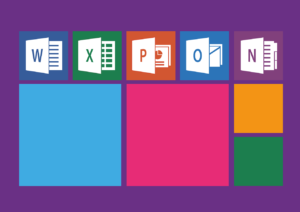
We can’t imagine our lives without productivity suites anymore. Microsoft Office has enabled us to create various textual files, presentations, spreadsheets, etc., which completely changed the way students and instructors exchange information. Google Classroom became a life-savior for many teachers, especially during the pandemic, as it provided a comfortable space for them to interact with learners online. Even when we, the grad students, are working on a project together, our first step is always creating a shared space on a cloud platform like Google Workplace and Microsoft One Drive to brainstorm ideas and make initial drafts. As productivity tools become more and more widely used in the sphere of education, the question of their advantages, drawbacks, and future development becomes increasingly relevant.
The Influence of Productivity Suites on Learning

During the interactive part of the presentation held by my talented colleagues Ayushi, Gagan, and Mohammad, the facilitators conducted a poll asking the participants whether productivity suites help encourage or discourage creativity. My first thought was, “Of course they support creativity!” By the time I was ready to select the answer, I had already had some doubts, but I still voted in support of the productivity applications. However, the more I think about that, the more I see both the “light” and the “dark” sides of productivity suites.
On the one hand, productivity suites encourage student collaboration and make education more student-centered. Productivity applications allow instructors to effectively utilize cooperative and project-based teaching methods. For instance, Power Point has become almost a standard program for students’ projects, and similar tools such as Canva, Google Slides, or Prezi are also widely used by learners to prepare and demonstrate their creative assignments in class. Cloud platforms make cooperative teaching methods strive more than ever, as now learners are able to work on their tasks together even outside of the classroom. Moreover, productivity instruments are also helpful tools for the flipped classroom adherents who prefer their students to prepare for classes beforehand. Such platforms as Google Drive, Google Classroom, One Drive, and even our UR Courses website enable educators to conveniently share materials with learners. So, overall, there are plenty of ways productivity suites can benefit learning processes and outcomes.
As we have clearly witnessed in Ayushi, Gagan, and Mohammad’s presentation and in Dr. David Parsons’s lecture, productivity suites also fit well within several learning theories. For instance, Connectivism was developed as “a learning theory for the digital age” and was based on the fact that the interned has opened new ways for us to learn and share information. Connectivism is highly supportive of the idea of learning through online peer networks, and what can create a better environment for such networks than productivity suites? Consequently, productivity tools would be of great help to Community of Practice advocators who promote learning based on group participation and social relationships. With productivity suites, such relationships can be easily established between learners from all over the world.
On the other hand, according to the constructionist Seymour Papert, “nothing can be more absurd than an experiment in which computers are placed in a classroom where nothing else is changed.” I quite agree with this statement as I also believe that the new tools change the process of learning itself, and educators don’t always realize that. For instance, teachers should keep in mind that productivity tools may reduce students’ creativity and critical thinking skills as they provide too many ready-made formatting and editing options.
Another disadvantage of the cloud productivity platforms is that we often forget how fragile and vulnerable online world is, which was proven by one of my colleague’s experience. She works an ESL teacher, and she was actively using an interactive whiteboard to share resources and materials with her students. She also provided access to her whiteboard to her students, which allowed them to make edits and interact with the activities the teacher was displaying. Unfortunately, intentionally or by mistake, one of my colleague’s student once deleted the majority of materials that she had been accumulating on the interactive whiteboard over a long period of time, which made the instructor extremely frustrated. This example clearly shows that over-reliance on technology may cause one simple mistake or glitch to destroy long hours of one’s work, so backing up or keeping hard copies of the materials could always be good idea.
The Future of Productivity Suites (which rapidly becomes the present)

As it is mentioned in the article “Revolutionary Software: Milestones in the Development of Productivity Suites”, productivity suites have a bright future. In the next couple of years we would most likely witness the rise of productivity tools empowered by such technologies as artificial intelligence (AI), virtual reality (VR) and augmented reality (AR). Who knows, maybe in several years students will be using VR glasses in the classroom to create spectacular group projects set in other historical eras or even universes! As for AI, it is already increasing people’s productivity a lot by, for example, eliminating grammar mistakes in one’s writing or answering any questions in a flash. However, not all AI features align with the rules of academic integrity, which should be seriously considered by students.
The world of the productivity suites is not limited by just commonly used Google Workplace and Microsoft Office. Such open-source productivity suites as LibreOffice and Zoho Workplace can be employed to make learning more exciting and diverse. While LibreOffice is rather similar to Microsoft suite, it offers a wider range of educational instruments, such as a vector graphics and flowcharts creator or a formula editor. Zoho Workplace provides access to numerous built-in productivity applications which make group and/or business collaborations much easier.
By the way, as I was looking for the author of the “Revolutionary Software: Milestones in the Development of Productivity Suites” article for the reference purposes, I was astonished by the fact that it was actually composed by AI! How scary and at the same time exciting it is to realize that you are being taught by a machine, and you are citing the machine in your university assignment! However, as modern educators, we should do our best to embrace this new reality and find the ways for it to enhance our productivity and creativity.


